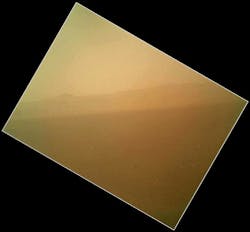Ocean Optics and LANL instruments land safely on Mars
Dunedin, FL and Los Alamos, NM--After surviving its rigorous descent to the red planet, NASA's Curiosity rover successfully delivered, among other photonic and scientific instrumentation, Ocean Optics and Los Alamos National Laboratory (LANL) instruments to Mars.
Ocean Optics spectrometers
Three customized Ocean Optics HR2000 spectrometers have completed their eight month journey to Mars to study soil composition as part of the ChemCam mission.
The Curiosity rover has the most advanced scientific instrumentation ever used to study the surface of Mars, and weighing in at 1 ton, has the heaviest payload. The 7 minute descent through Mars’ atmosphere relied on a complex landing sequence never before attempted. To withstand the rigors of space travel and descent, the onboard Ocean Optics spectrometers were modified to handle extreme temperature ranges, radiation, shock and vibration.
After landing, the work begins for the Ocean Optics spectrometers as the rover journeys to Mount Sharp, a 3 mile high mountain inside the crater, collecting data as it goes. The three modular HR2000 high-resolution miniature fiber optic spectrometers will study Martian rock and soil composition using Laser Induced Breakdown Spectroscopy (LIBS). Each ChemCam spectrometer is configured to detect elemental signatures over a different wavelength of light: 240-336 nm, 380-470 nm, and 470-850 nm. The use of the three spectrometers simplifies the design and creates redundancy, as many elements under study have spectral lines in more than one of the spectral ranges covered by the three units.
LANL ChemCam
Los Alamos National Laboratory scientists are ready to begin a nearly two-year-long mission that will use a rock-zapping laser device mounted on the mast of the SUV-sized rover to help unravel mysteries of the Red Planet. The ChemCam laser characterization instrument was developed at LANL and the French space institute, IRAP.
The ChemCam system is one of 10 instruments mounted on the mission's Curiosity rover—a six-wheeled mobile laboratory that will roam more than 12 miles of the planet’s surface during the course of one Martian year (98 Earth weeks). When ChemCam fires its extremely powerful laser pulse, it briefly focuses the energy of a million light bulbs onto an area the size of a pinhead. The laser blast vaporizes part of its target up to 7 m away.
The resultant flash of glowing plasma is viewed by the system's 4.3-inch aperture telescope, which records the colors of light within the flash. These spectral colors are then interpreted by a spectrometer, enabling scientists to determine the elemental composition of the vaporized material. ChemCam also has a high-resolution camera that provides close-up images of an analyzed location. It can image a human hair from 7 feet away.
The laser can profile through and study surface coatings on rocks, which, Earth scientists have learned, can often provide important clues to climate and water interaction, and can indicate biological interaction with surface materials. ChemCam is designed to look for lighter elements such as hydrogen, carbon, nitrogen, and oxygen, all of which are crucial for life, as well as to determine abundances of other elements. After firing its laser, the ChemCam system looks at the entire visible spectrum as well as portions on either side (the infrared and ultraviolet), which gives the instrument the ability to see any element in the periodic table. Researchers expect to take the first analyses of the Martian surface sometime on or after August 17-18, and the system is designed to capture as many as 14,000 observations throughout the mission.
Previously to Curiosity, NASA sent a pair of much smaller rovers, Spirit and Opportunity, to Mars in January 2004. Both rovers gathered a wide range of rock and soil data that have helped provide important information about the wet environments on ancient Mars that may have been favorable to supporting microbial life. The Opportunity rover continues to gather data and send images and information back to Earth—surpassing its planned mission by many years.
SOURCES: Ocean Optics; http://halmapr.com/news/oceanoptics/2012/08/06/ocean-optics-spectrometers-land-safely-on-mars/ and LANL; www.lanl.gov/news/releases/los_alamos_laser_instrument_arrives_on_red_planets_surface.html

Gail Overton | Senior Editor (2004-2020)
Gail has more than 30 years of engineering, marketing, product management, and editorial experience in the photonics and optical communications industry. Before joining the staff at Laser Focus World in 2004, she held many product management and product marketing roles in the fiber-optics industry, most notably at Hughes (El Segundo, CA), GTE Labs (Waltham, MA), Corning (Corning, NY), Photon Kinetics (Beaverton, OR), and Newport Corporation (Irvine, CA). During her marketing career, Gail published articles in WDM Solutions and Sensors magazine and traveled internationally to conduct product and sales training. Gail received her BS degree in physics, with an emphasis in optics, from San Diego State University in San Diego, CA in May 1986.
